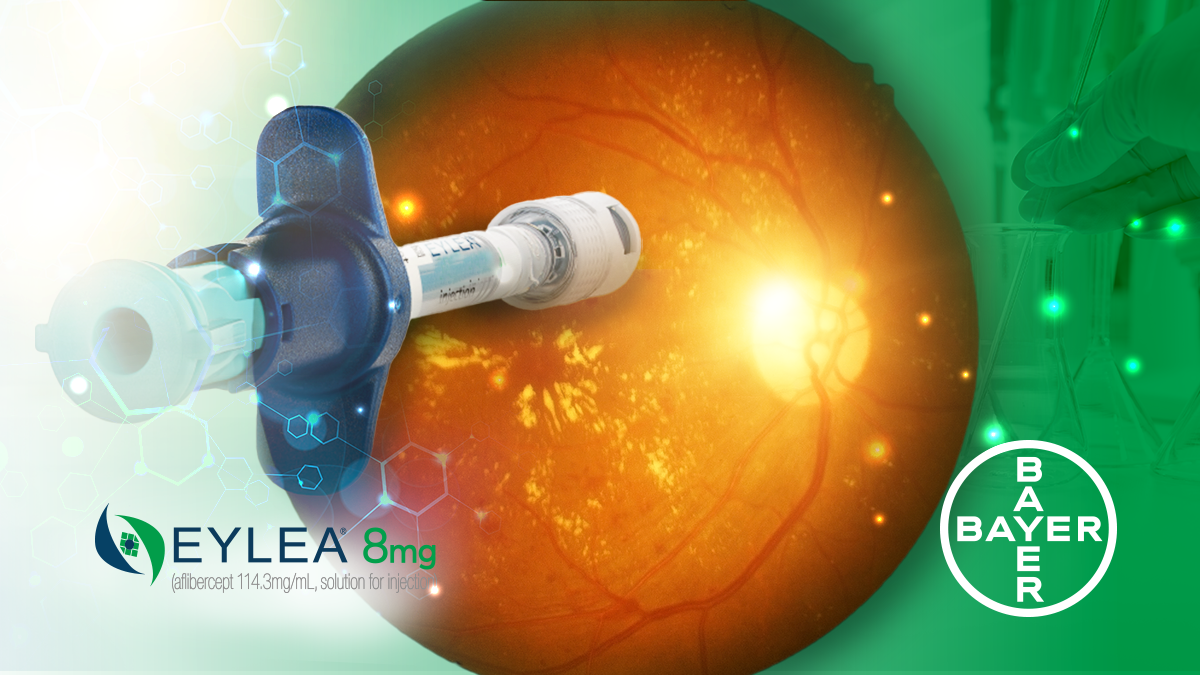Bayer filed for EMA approval to extend aflibercept 8 mg treatment intervals to six months.
Bayer (Leverkusen, Germany) submitted an application to the European Medicines Agency (EMA) yesterday to expand treatment intervals of up to six months for aflibercept 8 mg in both neovascular age-related macular degeneration (nAMD) and diabetic macular edema (DME).
“Longer dosing intervals address a critical unmet medical need and offer patients living with retinal diseases greater flexibility and a reduced burden from frequent injections and hospital visits. This is also important to those that care for these patients,” said Christine Roth, executive vice president of Global Product Strategy and Commercialization at Bayer, in a news release.
“Eylea 8 mg was the first anti-VEGF to receive a five-month label in the EU, and the new data support a substantial proportion of patients have the potential to maintain six-month-extended treatment intervals.”
Data-driven application
This submission comes on the heels of positive three-year results from the open-label extension studies of the PULSAR and PHOTON trials, released via news release and based on a presentation at Bascom Palmer Institute (Miami, FL, USA) made on Saturday.
In PHOTON, 28% of DME patients achieved a final dosing interval of six months, while in PULSAR, 24% of nAMD patients reached the same milestone.
We’re pleased to present positive three-year data from an extension study of our Phase 3 trial in patients with wet age-related macular degeneration at the Angiogenesis, Exudation, and Degeneration 2025 annual meeting.
— Regeneron (@Regeneron) February 8, 2025
Learn more: https://t.co/D0PRCVTHAl
Regeneron announces three-year data from the phase III nAMD trial on its X page.
According to the recent results from the PULSAR clinical trial, aflibercept 8 mg demonstrated durable visual acuity gains and fluid control. Among patients who were initially randomized to aflibercept 8 mg, 40% had a final assigned dosing interval of at least five months. The study also showed robust reductions in mean central retinal thickness (CRT) from baseline, which were maintained through the study period.
“We are excited about the reassuring long-term data of Eylea 8 mg, which spotlight that a substantial proportion of patients can experience benefits of long treatment intervals with just one injection of Eylea 8 mg every six months,” said Prof. Tien Y. Wong (China). “Based on the positive data, I am confident that Eylea 8 mg has the potential to become the new standard of care in retinal diseases.”
The extended dosing intervals could reduce the treatment burden for patients and caregivers while maintaining therapeutic effectiveness. Given the growing prevalence of nAMD due to an aging population, the need for longer-lasting treatments is increasingly critical.
“With an aging population and a rising prevalence of wet age-related macular degeneration, there is an urgent need for more durable treatments,” Roth noted. “We are delighted that long-term results for Eylea 8 mg have demonstrated its potential in addressing this important need of patients, caregivers and ophthalmologists.”
The safety profile of aflibercept 8 mg remained favorable throughout the three-year study period and was consistent with that of aflibercept 2 mg. No new safety concerns emerged among the treatment groups. Intraocular inflammation rates remained low, with 2.4% in patients who switched to aflibercept 8 mg and 1.9% in patients who were originally randomized to the higher-dose treatment. Additionally, no cases of occlusive vasculitis were reported.
The PULSAR open-label extension study followed patients with nAMD who had completed 96 weeks in the initial trial. Participants either continued their existing aflibercept 8 mg regimen or switched from aflibercept 2 mg to the higher dose without requiring initial monthly loading doses.
Over 90% of enrolled patients completed the study, with monitoring intervals shifting from every four weeks to every 12 weeks as the trial progressed. Treatment intervals were extended or shortened based on disease activity, with a maximum interval of 24 weeks (six months) and a minimum of eight weeks (two months).
Editor’s Note: This content is intended exclusively for healthcare professionals. It is not intended for the general public. Products or therapies discussed may not be registered or approved in all jurisdictions, including Singapore.
